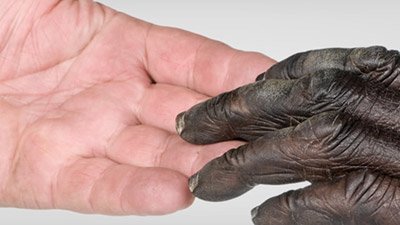
Denisovan Human Genome Sequenced
Revolutionary DNA sequencing technique said to be “a powerful new tool to fish for genes that have recently evolved.”
News Source
- Science: “A Home Run for Ancient DNA”
Before leaving 2012 behind, it is worth noting the discovery that headed the Science Magazine runner-up list for “Breakthrough of the Year.” Ranking just behind the hitherto elusive Higgs boson and in the same elite group with Curiosity’s arrival on Mars, the new technique for sequencing ancient DNA discovered by Matthias Meyer of Germany’s Max Planck Institute for Evolutionary Anthropology made the 2012 closing headlines. We discussed that discovery here on November 5, explaining that Denisovan DNA has left a footprint in the genomes of some modern humans. (This discovery of course is completely consistent with biblical history. All humans since the time of the global Flood share a common ancestry from Noah’s family.)

This tiny replica of the fossilized bit of bone from a Denisovan girl, along with a couple of teeth, is currently the only known fossil evidence of the Denisovan people. A new DNA-sequencing technique has unlocked many of its secrets. But which of those secrets can be read from the DNA, and which are unsupported inferences? Image credit: copyright Max Planck Institute for Evolutionary Anthropology, Leipzig, Germany www.mpg.de.
“Ancient DNA” like that recovered from a Denisovan girl’s finger bone and Neanderthal fossils tends to be degraded to single-stranded fragments. Matthias Meyer’s method allows those fragments to be sequenced, allowing a more complete peek at the genome of their long-dead owner. This breakthrough is exciting, but let’s take a brief look at the reasons it gets kudos from Science Magazine in order to be better prepared for both the information and interpretations expected in the new year as the technique is applied to more DNA samples.
Because the Denisovan finger bone and teeth belonged to a human being, the researchers were able to “read” some of the genetic code. The DNA fragments can be matched up to their corresponding places on the modern human genome. The Denisovan girl probably had brown hair and eyes and a brown-toned skin. But what other claims propelled this discovery to the top-rank in Science Magazine’s eyes? The editors write:
It also allowed the team to use DNA to estimate that the girl died between 74,000 and 82,000 years ago—the first time researchers had used genomic information to date an archaic human. The high quality of the genome gives researchers a powerful new tool to fish for genes that have recently evolved, providing a “near-complete” catalog of the handful of genetic changes that separate us from Denisovans, who were close kin to Neandertals.
Can DNA be used to “date an archaic human” with the same reliability as it can be used to supply the colors for her portrait? Does the fishing expedition for genes supply evidence of a human evolutionary pathway from ape-like ancestors through primitive humans to the intellectual paragons of today? The answer to both of these questions is “no.”
But the inferences about how long ago Denisovans lived are based on unverifiable, worldview-based assumptions.
Since the Denisovan’s DNA is human DNA, it is reasonable to “read” its information using what we know of modern human DNA. Conclusions about eye color and recognition of Denisovan DNA signatures in the DNA of some modern southeast Asian people are reasonable in light of observable, experimental, operational science. All the subjects involved in these interpretations are actual humans. But the inferences about how long ago Denisovans lived are based on unverifiable, worldview-based assumptions. Molecular clock dating requires not only assumptions that mutation rates have remained constant but also calibration dates. Those dates are derived from the scientifically unverifiable interpretations of radiometric dating methods dictating the age of the layers in which fossils are found. Thus the “clock claims” about when Denisovans lived are not acceptable.
Evolutionary anthropologists assume that hundreds of thousands of years elapsed between the evolutionary advent of various Homo species on the earthly scene. And they assume that humans must have gradually evolved from ape-like ancestors and through a series of progressively less primitive human forms. Yet nothing about Denisovan DNA discoveries supports this view. The Denisovans and Neanderthals were simply humans who lived in the post-Flood world, and like some other varieties of humans they have left their fossilized remains in Ice Age sediment. Denisovan and Neanderthal genes are so human because they are human, and their differences with modern humans are simply human variations. Their lives and their extinction are not evidence for either molecules-to-man evolution or proof that humans had to evolve through primitive evolutionary forms.
Further Reading
- Modern East Asians and Denisovans Share Genes (Denisovan cousins)
- Neanderthals vs. Humans: Are They Different?
- When Did Cavemen Live?
- Were Cavemen Real?
- “Homo” Diversity or “Homo” Ancestry? (Homo antecessor)
- News to Note, December 31, 2011: Year in Review (“Circular clock,” a discussion of the circular assumptions underlying molecular clock dating)
- Was the Tower of Babel Dispersion a Real Event?
- Where Does the Ice Age Fit?
- Radiometric Dating: Making Sense of the Patterns
- Radiometric Dating: Problems with the Assumptions
- Radiometric Dating: Back to Basics
- Those Enigmatic Neanderthals
For More Information: Get Answers
Remember, if you see a news story that might merit some attention, let us know about it! (Note: if the story originates from the Associated Press, FOX News, MSNBC, the New York Times, or another major national media outlet, we will most likely have already heard about it.) And thanks to all of our readers who have submitted great news tips to us. If you didn’t catch all the latest News to Know, why not take a look to see what you’ve missed?
(Please note that links will take you directly to the source. Answers in Genesis is not responsible for content on the websites to which we refer. For more information, please see our Privacy Policy.)
Recommended Resources

Answers in Genesis is an apologetics ministry, dedicated to helping Christians defend their faith and proclaim the good news of Jesus Christ.
- Customer Service 800.778.3390
- © 2024 Answers in Genesis




